 |
|
||||||||||
|
 |
|
||||||||||
|
The Internet offers language educators many online listening-based learning environments designed to meet the study needs of ESL learners. This article will provide an overview of some of the many listening websites available on the World Wide Web. While the content focus and language level of these sites vary, the websites examined here all make use of recent developments in network audio and video technologies.
The computer has long been perceived as a useful tool in the teaching of listening (Brett 1995, Higgins 1995, Hoven, 1999). In recent years, the rise of the Internet has provided new opportunities for increasing numbers of language educators to make available to learners online-based listening activities. Moreover, at the same time, the quality of Internet audio has improved dramatically. At present learners can access Internet audio through a variety of browser-based multimedia players; software applications designed to provide high quality audio and in some cases video over the Internet. Among the most common players are Apple's QuickTime (http://www.apple.com/quicktime), Real Systems'RealPlayer (http://www.realaudio.com) (see screen capture below) and Macromedia's Shockwave (http://www.macromedia.com/shockwave/). These user-friendly applications are found on most desktop computers and may also be downloaded and installed (in Mac or Windows versions) as freeware from the Internet. The web sites discussed in this paper utilize these players.
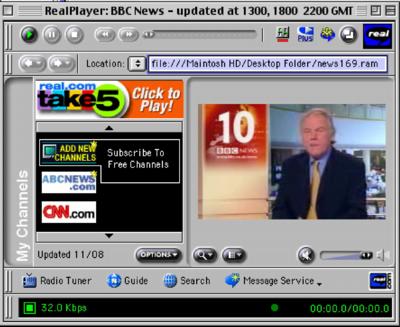
This comprehensive website contains a large number of audio- and video-based listening-comprehension exercises. All the listening activities are graded and are thus suitable for language learners of all levels. The listening tasks focus on everyday activities, while the video-based content focuses on higher-level topics.
Innovative features of this site include an online student-study guide, help page and mailing list. This site also contains an online bulletin-board where teachers and students may post questions relating to the site.
The learning tasks require the use of freeware audio and video players which may be downloaded from this website. A screen capture of the ESL Cyber Listening Lab gateway page is reproduced below:
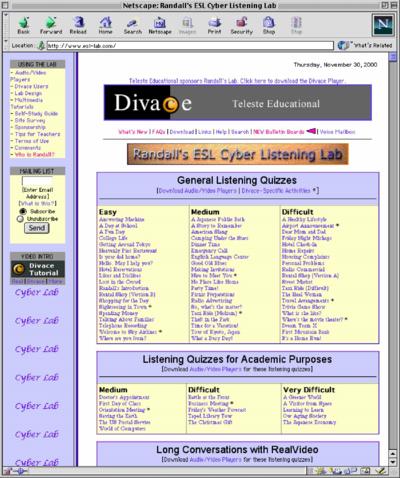
(http://www.englishlistening.com)
This website contains over 30 graded listening quizzes based on authentic native-speaker dialogues. Topics covered include family, travel, foreign customs and sports. Learners may gain access to a transcript of all dialogues, and answers to all the questions are also available. An online help page and search engine are also provided. Japanese-language support for this site appears to be under development. The Real Systems RealAudio player is required to play the audio files. A screen capture of a listening lesson is reproduced below:
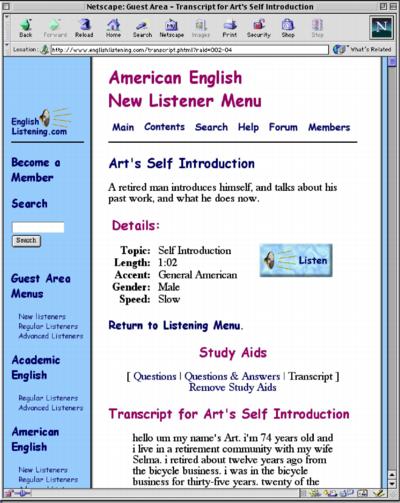
(http://www.bbc.co.uk/worldservice/learningenglish/index.shtml)
This website encompasses a range of listening-based language-learning activities designed for intermediate-level learners. Most of the content is derived from BBC news and educational programs. Other areas of interest covered include sports, music and current affairs. The site provides users with access to BBC radio news reports online, and transcripts of the audio are provided onscreen. This website also hosts an online mailing list that acts as forum for discussion regarding English as a second language. In addition, the site contains a section designed as a resource for language teachers. A screen capture of this website is reproduced below:
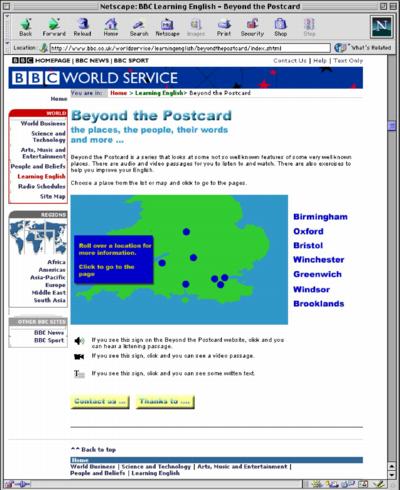
(http://www.stir.ac.uk/departments/humansciences/celt/Listen/index.html)
This extensive site contains a variety of listening-based language activities.
Six groups of online tasks are available: logic puzzles with sound clues, crossword puzzles with sound clues and two audio-based treasure hunts, an exercise on discovering hidden words and a telephone-message activity. The majority of these lessons are of multiple-choice format and in most cases online answers with feedback are provided (see screen capture):
The lessons in the above site require the freeware Divace Media Player which may be downloaded from: http://www.divace.com/index.html.
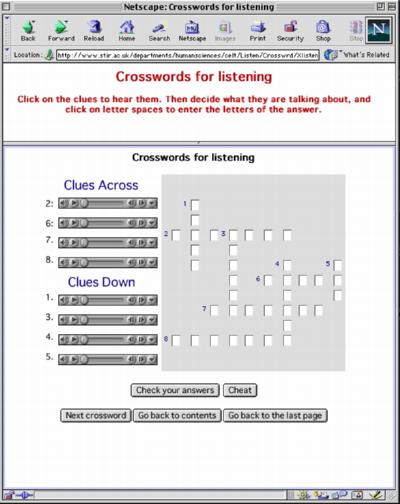
(http://www.otan.dni.us/cdlp/education/education.html)
The Interactive Learning Resources website was created by the California Department of Education and supplies learners with audio-based interactive listening lessons. After downloading a short audio clip of a native-speaker dialogue, users may then test their comprehension by selecting from several interactive multiple choice activities that focus on the areas of vocabulary, sequencing and inferencing. An example of an exercise interface is reproduced in the following screen capture:
This site contains over 70 lessons and the content focuses on contemporary news and current affairs in the United States.
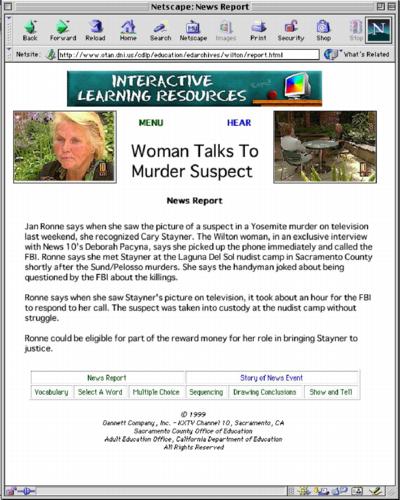
(http://www.studint.net/takako/)
This site is composed of 10 interactive listening activities. The total length of the narrative is 100 minutes. Learners are provided with access to multiple-choice questions, cloze exercises, text-reconstruction activities and vocabulary-retention tasks based on the TL audio. An innovative feature of this site is the online dictionary that provides meanings of highlighted key words in the dialogue. This site requires the Shockwave multimedia plugin which may be downloaded from: http://www.macromedia.com/shockwave/.
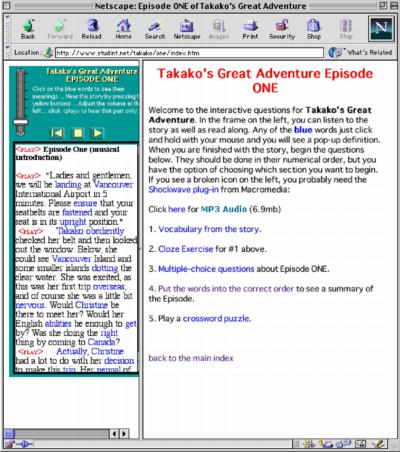
(http://deil.lang.uiuc.edu/LCRA/)
The above activities (designed for intermediate and advanced learners) form part of the extensive LinguaCenter website at the University of Illinois, Urbana-Champaign. This site contains six lessons based on current affairs and is structured to assist the development of listening skills. Before accessing the audio, learners are invited to predict the answers to onscreen questions through selecting from onscreen menus. Students may then listening to the audio and check their answers and reaction times. Online transcripts of some of the articles are available. A screen capture of an exercise in this site is reproduced below:
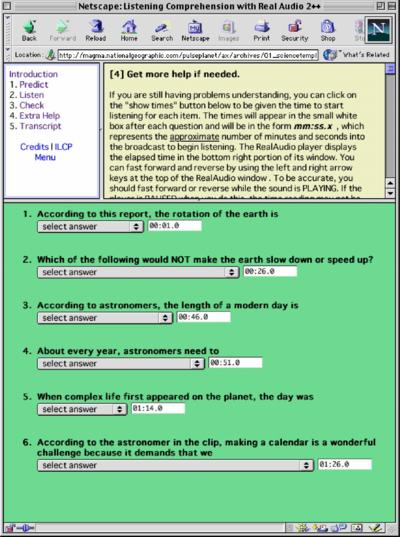
The sites reviewed here represent a fraction of the ESL-focused multimedia content available on the Internet. As technology continues to improve, increasing numbers of language educators will use multimedia content creation tools to produce online learning environments designed to meet learner needs. The design of these environments will soon become a major focus in language education worldwide. The challenge for the future lies in the way we, as educators, make the most of the opportunities technology provides.
Brett, P. (1995). Multimedia for listening comprehension: The design of a multimedia-based resource for developing listening skills. System 23(1), 77-85.
Higgins, J. (1995). Computers and English Language Learning. Oxford: Intellect.
Hoven, D. (1999) A model for listening and viewing comprehension in multimedia environments. Language Learning and Technology 3(1), 88-103. Available: http://llt.msu.edu/vol3num1/hoven/index.html
|
© Copyright rests with authors. Please cite TESL-EJ appropriately. Editor's Note: Dashed numbers in square brackets indicate the end of each page for purposes of citation.. |
|
||||||||||